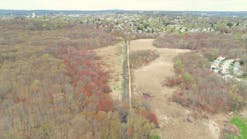Zoos Use Green Infrastructure to Manage Stormwater
Increasingly, zoos in America are using green infrastructure to manage their stormwater, and they’re doing so in a variety of creative and innovative ways. This practice shouldn’t be surprising, given the mission of zoos and their natural interest in safeguarding the environment.
“We have a duty and an opportunity to take these things and educate people about them, so we have signs at our exhibits that ask ‘Where’s the water come from?’ and ‘What’s under your feet?’” says Mark Fisher, P.E, director of facilities and planning at the Cincinnati Zoo and Botanical Garden.
He adds, “Our education people talk about stormwater while they talk to visitors about the animals.
“School groups come [to the Rosamond Gifford Zoo] to see green infrastructure, not just the animals,” says Joanne Mahoney, Onondaga County (NY) Executive.
“When zoos were created, they were for exhibiting animals. Now they are so much more about conservation. Conserving water and energy is a natural extension of zoos’ conservation of animal species,” says Emily Dawson, AIA, an associate with SRG Partnership Inc. and designer of the Elephant Lands exhibit at the Oregon Zoo in Portland.
One of the reasons that zoo officials see value in capturing stormwater and cleaning it through green infrastructure for use within the zoos is that their need for water is unrelenting. Landscaping has to be irrigated. Visitor areas and animal exhibits must be kept clean, and hosing them down is quick.
Even if a zoo doesn’t have marine animals, plenty of species require ponds to swim and play in. In the past these pools, especially those for birds, had to be emptied, scrubbed, and refilled with tap water. That’s costly in terms of both labor and water. It adds to the volume of wastewater flowing into the city sewers and increases stormwater utility fees. Green infrastructure has cut these costs.
“Our water usage is down 80% from eight years ago,” says Fisher.
The North Carolina Zoological Park in Asheboro has wetlands adjoining its manmade North America Lake (10 acres) and Africa Lake (12 acres). Two 20-horsepower pumps operate at Africa Lake because the water has to be pumped up 100 feet. North America Lake has one 15-horsepower pump.
“The irrigation pumps are generally running 24/7,” says Gerry Parker, P.E., the zoo’s director of facilities. The cleaned and reused water “keeps moats like those at the lemurs’ and elephants’ exhibits topped off.”
Parker adds, “There’s an artificial stream in the giraffes’ area. The pumped irrigation water keeps it running. We save a tremendous amount of water.”
Fisher says that managing stormwater at a zoo has some unique challenges compared to managing it elsewhere. “First of all, we have a very diverse set of surfaces—roof asphalt, parking lots, walkways, and areas with different chemicals that we use for disinfecting. They get in the runoff.”
The spread of a zoonotic disease (one that can be spread from one species to a different one) is a constant concern. “For example, rain falls on the giraffe yard and goes into the tank, and then we send it to the polar bears’ area,” he says. “How do we filter it to keep the water safe for the polar bears?”
Fisher adds, “Our biggest challenge in general with stormwater and our open systems is dealing with dirt, mulch—that heavy stuff. It wreaks havoc on our filters. We’ve had to add prefilters in front of the prefilters. We’re getting better at keeping heavy debris out of the system, but it’s a constant effort.”
Some of the stormwater management at the Cincinnati Zoo and Botanical Garden is in the hands—er, paws—of the cheetahs. More accurately, it’s under their paws. And also under the hooves of the gazelles.
That’s because the cheetahs’ landscape and adjacent ones for other African animals comprise the Cincinnati Zoo’s $32 million African Savannah exhibit. The land is a 20-acre watershed within the zoo’s campus.
Only a few years ago, the space was a large impervious parking lot that sent millions of gallons of untreated runoff into Cincinnati’s overloaded combined sewer system. Now, thanks to some amazing design and engineering work and wise deployment of green infrastructure, the site infiltrates about one-third of the zoo’s stormwater, 15 million gallons annually.
“The African exhibit has validation for me that there are relatively common-sense solutions to these huge problems [of stormwater management in large areas]. It’s rewarding and validating to know that these are simple solutions, homegrown engineering, and they work,” says Fisher.
The central part of managing stormwater in the African Savannah exhibit is a 55,000-gallon storage tank with liner by StormTech. Positioned beneath the areas for the African painted dogs and the gazelles and other hoofed mammals, the tank receives runoff from the entire exhibit.
“It’s 15 feet deep and the size of an NFL football field,” says Fisher.
Managing stormwater in this section of the zoo was made challenging because it has “serious groundwater issues,” explains Fisher. “Water levels are inconsistent. Dig in one spot, and it’s like a waterfall. Go 20 feet away, and there’s no water.”
The other major challenge with the African Savannah exhibit was that “nobody has done anything like this in the US. There were no manuals, no examples, no white papers to follow,” says Fisher.
Because the exhibit is a 20-acre watershed, there are many interconnections within it. One example is the giraffe yard’s moats, which collection stormwater and send it through French drains into the lions’ exhibit area.
The zoo’s new parking lot across Vine Street has more than 40,000 square feet of pervious concrete paving. Because of the area’s expansive clay soil, the parking lot was designed to have its own detention system.
The pervious concrete was designed with 15 to 21 inches of #2 washed, recycled concrete as a base. Recycled 304s were added to the top 2 inches. Under the gravel is a woven filter fabric with drain pipes running parallel to the length of the parking stalls and perpendicular to the main at approximately every 40 feet.
The catch basins were set at elevations to allow runoff to enter the storm sewer, but only if the entire system was overloaded. The work was done by McD Concrete of Alexandria, KY.
Other examples of green infrastructure at the Cincinnati Zoo include three green roofs. They are over the Primate Center (about 2,000 square feet), the African painted dog exhibit (about 1,000 square feet), and the Giraffe Ridge Barn (2,400 square feet).
“Our rain gardens are concentrated at the education center, parking lot, and escalator and elevator building. At four of our buildings all of the rain that falls on the roofs goes into rain gardens,” says Fisher.
Historic Village, the entry point for the zoo, has about 30,000 square feet of pervious pavers. They were supplied by Reading Rock, a Cincinnati company.
Cincinnati’s Metropolitan Sewer District (MSD) works closely with the zoo. Fisher says that because the zoo “has been here for 130 years, people have confidence is us. They know we’ll maintain the [new or innovative] system. Unlike a developer who may be gone in five years, we’re not going away.”
That stability means that sometimes it’s easier for the zoo to secure approval or variances from MSD or other regulatory agencies for projects. “We’re a 60-acre pilot for all of these sustainable strategies,” he adds.
The first part of the African Savannah exhibit was completed in April 2009. The cheetahs’ section opened in 2013, and more areas will be developed.






